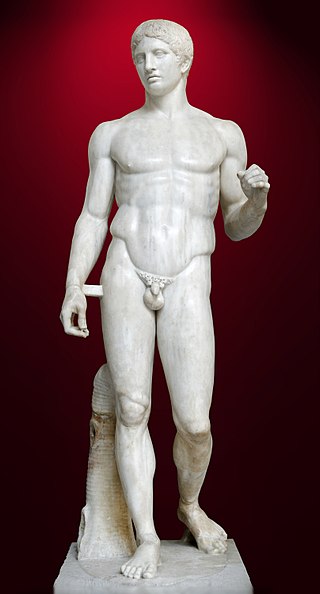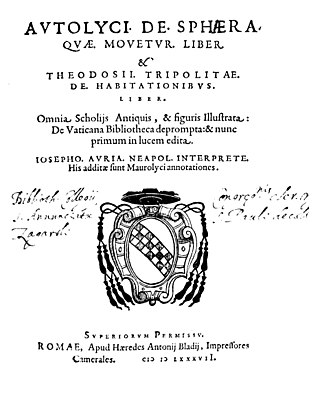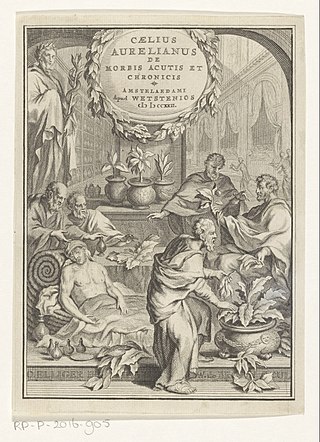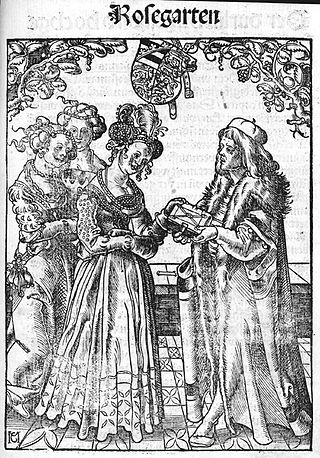External links
- Google books copy of 1882 Teubner edition by Valentin Rose
| International | |
|---|---|
| National | |
| Other | |
Muscio (also Mustio) is the supposed author of the Genecia (Gynaecia), a treatise of gynecology dating to ca. AD 500, preserved in a manuscript of ca. AD 900. [1] The treatise borrows heavily from Soranus.
Nothing is known about the life of Muscio. Analysis of his vocabulary suggests that he may have come from North Africa. The usually cited 6th century date for his work is somewhat doubtful. [2] His one surviving work is a simplified, and abbreviated, Latin translation of the Gynecology of Soranus. The first part is composed in a form of question-and-answer on many matters to do with female anatomy, embryology, and matters of birth and neonatal care. The second part covers pathological conditions. Numerous copies of this work from the ninth to the fifteenth century still survive, and it was the most important source for Eucharius Rösslin when he wrote his Rosengarten in 1513. [3]
In Byzantine times, the work was translated into Greek, and, as a result, Muscio came to be thought of as Greek and wrongly identified with Moschion, a Greek physician mentioned by Soranus. [4]
Tatian of Adiabene, or Tatian the Syrian or Tatian the Assyrian, was an Assyrian Christian writer and theologian of the 2nd century.

Polykleitos was an ancient Greek sculptor, active in the 5th century BCE. Alongside the Athenian sculptors Pheidias, Myron and Praxiteles, he is considered as one of the most important sculptors of classical antiquity. The 4th century BCE catalogue attributed to Xenocrates, which was Pliny's guide in matters of art, ranked him between Pheidias and Myron. He is particularly known for his lost treatise, the Canon of Polykleitos, which set out his mathematical basis of an idealised male body shape.
De re militari, also Epitoma rei militaris, is a treatise by the Late Latin writer Publius Flavius Vegetius Renatus about Roman warfare and military principles as a presentation of the methods and practices in use during the height of the Roman Empire and responsible for its power. The extant text dates to the 5th century.

Berossus or Berosus was a Hellenistic-era Babylonian writer, a priest of Bel Marduk and astronomer who wrote in the Koine Greek language, and who was active at the beginning of the 3rd century BC. Versions of two excerpts of his writings survive, at several removes from the original.
Moschion,, is a physician quoted by Soranus, Andromachus, and Asclepiades Pharmacion, who lived in or before the 1st century. He may be the same person who was called the "Corrector", because though he was one of the followers of Asclepiades of Bithynia, he ventured to controvert his opinions on some points.

Autolycus of Pitane was a Greek astronomer, mathematician, and geographer. He is known today for his two surviving works On the Moving Sphere and On Risings and Settings, both about spherical geometry.

The Secretum Secretorum or Secreta Secretorum, also known as the Sirr al-Asrar, is a treatise which purports to be a letter from Aristotle to his student Alexander the Great on an encyclopedic range of topics, including statecraft, ethics, physiognomy, astrology, alchemy, magic, and medicine. The earliest extant editions claim to be based on a 9th-century Arabic translation of a Syriac translation of the lost Greek original. It is a pseudo-Aristotelian work. Modern scholarship finds it likely to have been written in the 10th century in Arabic. Translated into Latin in the mid-12th century, it was influential among European intellectuals during the High Middle Ages.
Johannes Cotto was a music theorist, possibly of English origin, most likely working in southern Germany or Switzerland. He wrote one of the most influential treatises on music of the Middle Ages, De musica, first printed by Gerbert in 1784. The treatise included unusually precise directions for composing chant and organum.

The Doryphoros of Polykleitos is one of the best known Greek sculptures of Classical antiquity, depicting a solidly built, muscular, standing warrior, originally bearing a spear balanced on his left shoulder. Rendered somewhat above life-size, the lost bronze original of the work would have been cast circa 440 BC, but it is today known only from later marble copies. The work nonetheless forms an important early example of both Classical Greek contrapposto and classical realism; as such, the iconic Doryphoros proved highly influential elsewhere in ancient art.

De re publica is a dialogue on Roman politics by Cicero, written in six books between 54 and 51 BC. The work does not survive in a complete state, and large parts are missing. The surviving sections derive from excerpts preserved in later works and from an incomplete palimpsest uncovered in 1819. Cicero uses the work to explain Roman constitutional theory. Written in imitation of Plato's Republic, it takes the form of a Socratic dialogue in which Scipio Aemilianus takes the role of a wise old man.

Caelius Aurelianus of Sicca in Numidia was a Greco-Roman physician and writer on medical topics. He is best known for his translation from Greek to Latin of a work by Soranus of Ephesus, On Acute and Chronic Diseases. He probably flourished in the 5th century, although some place him two or even three centuries earlier. In favour of the later date is the nature of his Latin, which shows a strong tendency to the Romance, and the similarity of his language to that of Cassius Felix, also an African medical writer, who about 450 wrote a short treatise, chiefly based on Galen.

The Geographica or Geography, is an encyclopedia of geographical knowledge, consisting of 17 'books', written in Greek in the late 1st century BC, or early 1st century AD, and attributed to Strabo, an educated citizen of the Roman Empire of Greek descent. There is a fragmentary palimpsest dating to the fifth century. The earliest manuscripts of books 1–9 date to the tenth century, with a 13th-century manuscript containing the entire text.

Soranus of Ephesus was a Greek physician. He was born in Ephesus but practiced in Alexandria and subsequently in Rome, and was one of the chief representatives of the Methodic school of medicine. Several of his writings still survive, most notably his four-volume treatise on gynecology, and a Latin translation of his On Acute and Chronic Diseases.

Eucharius Rösslin , sometimes known as Eucharius Rhodion, was a German physician who in 1513 authored a book about childbirth called Der Rosengarten, which became a standard medical text for midwives.

Medicine in ancient Rome was highly influenced by ancient Greek medicine, but also developed new practices through knowledge of the Hippocratic Corpus combined with use of the treatment of diet, regimen, along with surgical procedures. This was most notably seen through the works of two of the prominent Greek physicians, Dioscorides and Galen, who practiced medicine and recorded their discoveries. This is contrary to two other physicians like Soranus of Ephesus and Asclepiades of Bithynia, who practiced medicine both in outside territories and in ancient Roman territory, subsequently. Dioscorides was a Roman army physician, Soranus was a representative for the Methodic school of medicine, Galen performed public demonstrations, and Asclepiades was a leading Roman physician. These four physicians all had knowledge of medicine, ailments, and treatments that were healing, long lasting and influential to human history.

Childbirth and obstetrics in classical antiquity were studied by the physicians of ancient Greece and Rome. Their ideas and practices during this time endured in Western medicine for centuries and many themes are seen in modern women's health. Classical gynecology and obstetrics were originally studied and taught mainly by midwives in the ancient world, but eventually scholarly physicians of both sexes became involved as well. Obstetrics is traditionally defined as the surgical specialty dealing with the care of a woman and her offspring during pregnancy, childbirth and the puerperium (recovery). Gynecology involves the medical practices dealing with the health of women's reproductive organs and breasts.
Moschion is the name of:
Commentaries on Plato refers to the great mass of literature produced, especially in the ancient and medieval world, to explain and clarify the works of Plato. Many Platonist philosophers in the centuries following Plato sought to clarify and summarise his thoughts, but it was during the Roman era, that the Neoplatonists, in particular, wrote many commentaries on individual dialogues of Plato, many of which survive to the present day.

The Rhetoric to Alexander is a treatise traditionally attributed to Aristotle. It is now generally believed to be the work of Anaximenes of Lampsacus.
Wandering womb was the belief that a displaced uterus was the cause of many medical pathologies in women. The belief is first attested in the medical texts of ancient Greece, but it persisted in European academic medicine and popular thought for centuries. The wandering womb as a concept was popularized by doctor Edward Jorden, who published The Suffocation of the Mother in 1603. Suffocation of the Mother was the first text on the subjects of the wandering womb and hysteria that was written in English.